Medieval Architecture - Quiz #1
1/98
There's no tags or description
Looks like no tags are added yet.
Name | Mastery | Learn | Test | Matching | Spaced |
|---|
No study sessions yet.
99 Terms
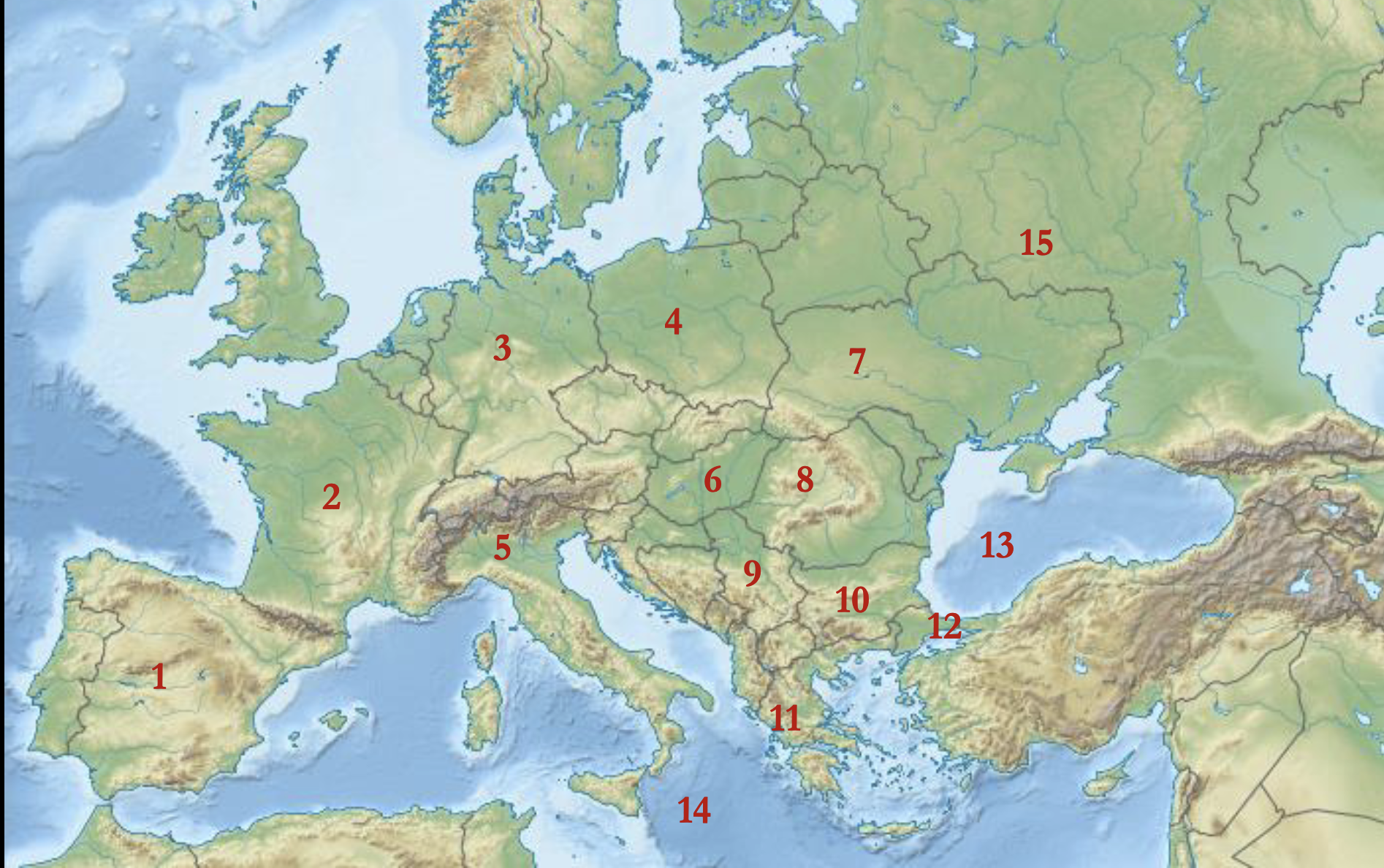
Name all regions
1: Spain
2: France
3: Germany
4: Poland
5: Italy
6: Hungary
7: Ukraine
8: Romania
9: Serbia
10: Bulgaria
11: Greece
12: Constantinople/Istanbul
13: The Black Sea
14: The Mediterranean Sea
15: Russia
Basilica
A rectangular building with a central nave and surrounding aisles, which the early Christians adopted for their churches after the Roman Empire
Atrium
An open-air courtyard at the entrance of a church or basilica, surrounded by covered aisles, serving as a gathering place for worshippers before entering the sacred interior
Narthex
An antechamber or porch at the west end of a church, serving as a transitional space between the exterior and the main worship area (the nave)
Nave
The central and principal part of a church, designed to hold the congregation
Aisle (side aisle)
A walkway or passageway located to the side of the central nave, separated from it by columns or piers. Usually lower in height than the nave and help support ceiling.
Transept
The transverse arm of a cruciform (cross-shaped) church that extends across the main body of the building, usually at right angles to the nave. Essentially a large horizontal piece intersecting the nave. Can be used to represent a cruciform shape or to accommodate extra space for worship.
Crossing
The central area of a cross-shaped (cruciform) church where the nave, choir, and transept arms intersect
Apse
A semicircular or polygonal recess, most often found at the eastern end of a church, that typically houses the altar (and clergy during service).
Altar
The main table within a church's choir or sanctuary where the Eucharist (Mass) is celebrated
Clerestory
The upper story of a building, particularly a church basilica, that contains windows and is situated above the roofs of the lower aisles. Its primary function was to admit natural light into the space and create a spiritual atmosphere
Columns
A vertical, often cylindrical or polygonal, structural element that bears the weight of roofs and vaults, transferring it to the foundation below
Architrave
The uppermost, horizontal, structural element of an entablature, resting directly on column capitals to support the roof or clerestory above.
Trussed wooden roof
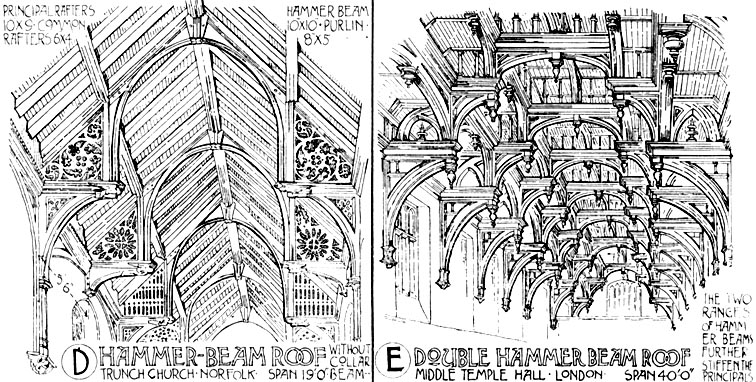
A triangular timber structural framework designed to bridge the space above a room and support a roof, allowing for long, open spans without the need for internal supporting columns
Fastigium
A prominent architectural canopy, often made of precious metal, that stood over an altar. This structure, which also functioned as a screen, represented the authority of the emperor and visually separated the altar area from the nave.
Baldachin

A ceremonial canopy of stone, metal, or fabric over an altar, throne, or doorway (think four posted structure).
Gallery
An upper-level passageway or balcony overlooking the main interior space, such as the nave of a church (often above the side-aisles or main space)

Tesserae
The small, often square, pieces of colored stone, glass, or ceramic used to create mosaics that decorate walls, ceilings, and floors
Doric
Most basic column capital, circular design.
Ionic
Middle-tier column capital, scroll-like design.
Corinthian
Highest-tier column capital, leaves and “cornucopia”-like design, very elaborate and most common within grand basilicas.
Opus Sectile
An inlay technique where thin, shaped pieces of colored stone, marble, or glass are cut and fitted together to create intricate designs on floors, walls, or furniture — often geometrical or figurative (LARGE pieces vs the SMALL tesserae pieces used to make mosaics).
Mica
Mineral, a semi-translucent sheet that is crystal-like to cover windows
Spolia
ABBrt and architectural elements taken from an older structure and incorporated into a new one
Barrel Vault
A semi-circular ceiling that extends back (looks like half of a barrel)
Basilican Plan
Provided the basic model for the development of church architecture in the West
Precedent: imperial basilica (cf. Basilica Ulpia, Basilica of Maxentius)
Wooden roof
Spacious interior – accommodating to a large number of worshipers
Encourages attention on the altar
(built to be like a basilica)
Central Plan
A floor plan organized around a central point, often circular, square, or in the shape of a Greek cross, creating a symmetrical and unified space
Round or polygonal in shape
Often domed
Often associated with funerary functions
Focus on central space – illuminated by clerestory windows
Sometimes with an ambulatory → an aisle/walkway that circles around the apse
Cross-in-Square Plan
A new kind of centrally planned church emerging in the 9th century, especially in Constantinople — features a central square nave with a domed ceiling supported by four columns, and four barrel-vaulted arms extending outward, forming a cross shape within the square.
Bema
Raised platform area in the east of the church (basically apse), containing altar and clergy with canopy
Prothesis
Where the communion was prepared
Eucharistic vessels were stored
(apse-ish area)
Diakonikon
Housed liturgical vestments and sacred texts
(apse-ish area)
Dome
A rounded roof or ceiling, often used in both Christian churches and mosques to symbolize the heavens or spiritual presence
Templon
Stone or marble screen/sectioning separating nave and altar
Iconostasis
A decorative screen or wall covered with religious icons, placed in Eastern Orthodox and some Eastern Catholic churches to separate the nave (the area for the congregation) from the sanctuary (the holiest part of the church) (evolved/decorated version of a templon)
Epistyle
Term referring to an architrave (same thing), but epistyle is a Greek word and architrave is a Latin word
Ashlar
Neatly cut rectangular stones stacked with precision
Brick
A small rectangular block typically made of fired or sun-dried clay, used in building
Mosaics
Images or patterns created from small, colored pieces of tesserae, such as glass, stone, or ceramics, used to decorate the interiors of churches, public buildings, and palaces
Stucco
A plaster-like finish, composed of lime, sand, and water, applied to walls and ceilings to provide decorative texture, mimic expensive materials like stone, and protect structures
Porphyry
Rare, hard, reddish-purple volcanic stone used in mosaics, sarcophagi, opus sectile
Voussoirs
A wedge-shaped stone or brick used to construct an arch or vault, distributing pressure and creating a self-supporting structure that can span wide openings
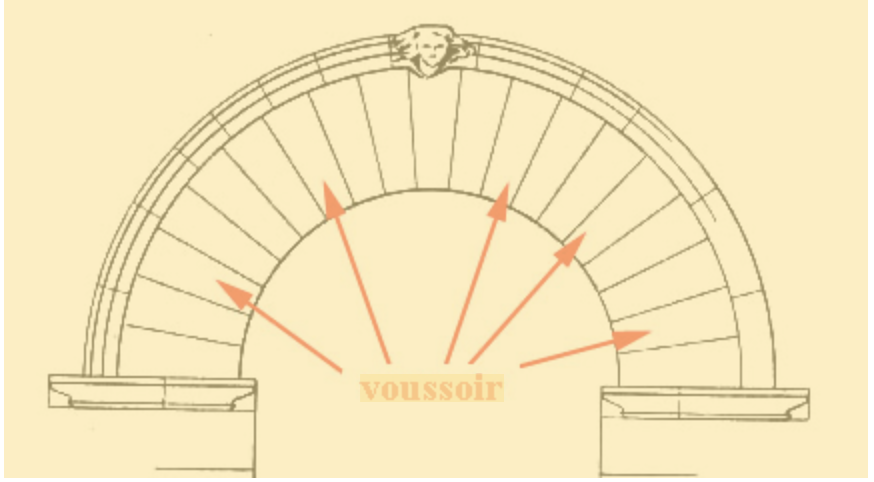
Keystone
The central voussoir directly vertical in the arch.
Piscine
Water font – a stone or metal basin or receptacle that holds consecrated water for Christian baptisms
Conches/Half-Domes
A half-domed ceiling (often in the apse)
Exedrae
A half-domed recess into the wall, usually covered by a larger conch/half-dome
Sanctuary
The sacred area within a church around the high altar where the clergy and sacred objects are located, usually in the apse
Pendentives
A spherical triangle which acts as a transition between a circular dome and a square base on which the dome is set
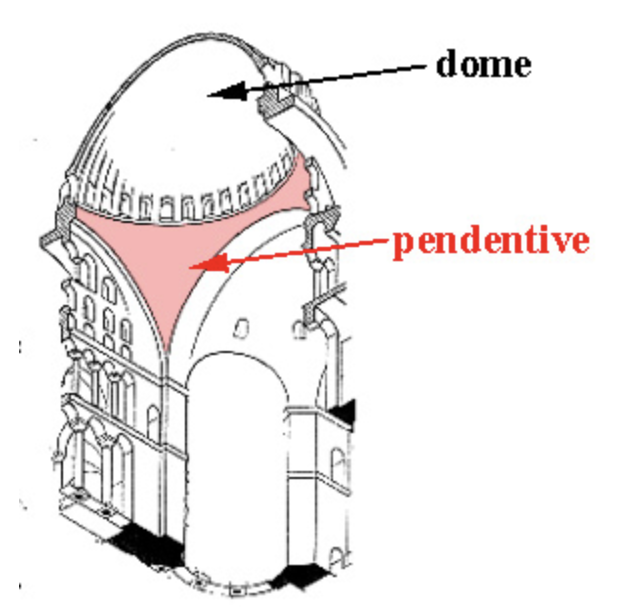
Central Dome
The larger central dome ceiling in centrally-planned churches, usually positioned over the naos/nave.
Iconoclasm
The destruction or rejection of religious images, driven by the belief that such images were a form of idolatry and a deviation from pure worship (essentially a purge of objects that are not deemed correct for faith or culture) — This happened on a large scale in the 8th and again in the 9th century
Theotokos
A central artistic and theological theme, particularly in Byzantine churches. The Greek title means "God-bearer" or "Mother of God," and its representation prominently in mosaics and frescoes defined the sacred spaces of the church. Essentially the depiction of Mary as the birth-giver to God in artwork in churches. In Hagia Sophia there is a very large one in the apse called Virgin and Child.
Constantine the Great
Ruled in early 4th century — first Christian emperor, ended persecution of Christians, supported them as a major religion in Rome and moved the capital to Constantinople (modern-day Istanbul). Built many larger buildings as churches and places of worship for Christians, replacing the former small house-churches.
Justinian I
Ruled early to mid 6th century, desired to restore the Western Roman Empire, constructed the Hagia Sophia as the premier Christian church in the Byzantine Empire, rebuilt following the Nika revolts (against Justinian).
Anthemius of Tralles and Isidorus of Miletus
Two mechanikoi or architect-engineers who constructed the Hagia Sophia
Mehmed II “the Conqueror”
Conquered Constantinople in the mid 15th century, ending the Byzantine Empire and the Middle Ages, changing the name to Istanbul. He was responsible for forming the Ottoman Empire.
Bishop Ecclesius
The founder of the Basilica of San Vitale in Ravenna, which was funded by a local banker during the reign of Justinian.
Katholikon
The main/central church of a monastery
Triconch Plan
A plan with three semi-dome ceilings/projections (usually one in the main apse and two on the flanking horizontal sides creating two more apses)
Choroi
The horizontal/lateral apses for the monks who sang the liturgy
Chrysobull
An official decree by Byzantine Emperors and later by European rules placing these monasteries under their jurisdiction by giving them land, supporting them, and promoting the tradition of gifting/donating to the monasteries in order to show your dedication to Christ and to the imperial rulers
Rhipidia
Fancy liturgical fans
The Burning Bush
A very famous and common symbol/story that is depicted often as mosaics or paintings in churches, represents the burning bush representing God that called Moses to free the Hebrews. “The call to prophetic ascent”
Deesis / Intercession
Very famous, mostly damaged mosaic in Hagia Sophia depicting Jesus flanked by St. John the Baptist and Mother Mary, largely seen as a symbol of receiving the prayers of the faithful
The Transfiguration
Major mosaic in the apse of St. Catherine’s Monastery, showing Christ radiating divine light to his apostles and prophets, “seeing of God as Christ”
Prophets
People believed to have a divine connection, who can bring messages and teachings from God to humanity
Apostles
Followers of Jesus Christ who were commissioned to spread his teachings
Christ’s dual nature: human and divine
Christ is both man and divine, both human and God, and therefore serves as a powerful symbol of human connection to the divine and the ability of humans to connect with God by worshipping Jesus.
Paten
A sacred, shallow metal plate or disc, typically made of precious metal like gold or silver, used in the Christian Eucharist to hold the Eucharistic bread, which is consecrated as the Body of Christ
Repousse (hammered) technique
Hammering and punching metal through the back to form images/depictions of holy events, symbols, etc.
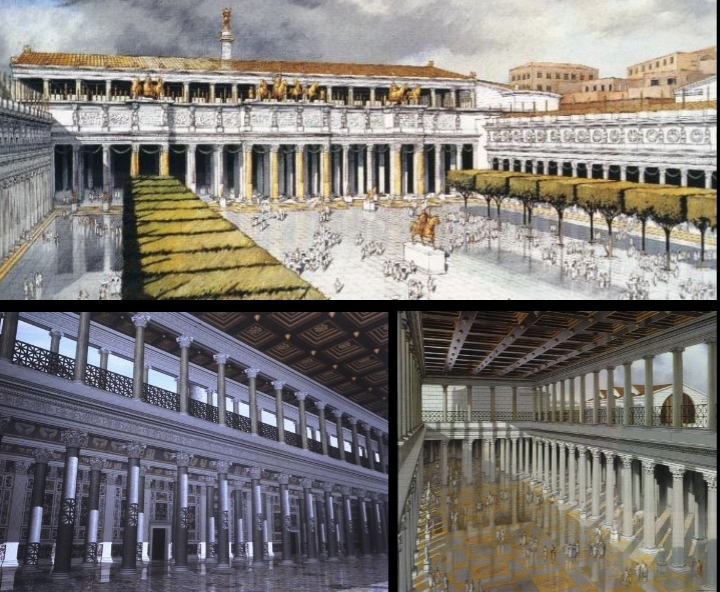
Basilica Ulpia, early 2nd century. Part of the Roman Forum, key features include nave, side aisles, clerestory (acted as gallery where people can walk), apse, trussed wooden roof, architrave above columns Largely civic functions (meeting hall, court house, royal hall/audience chamber, market). Prototype for Constantine’s early Christian basilicas.
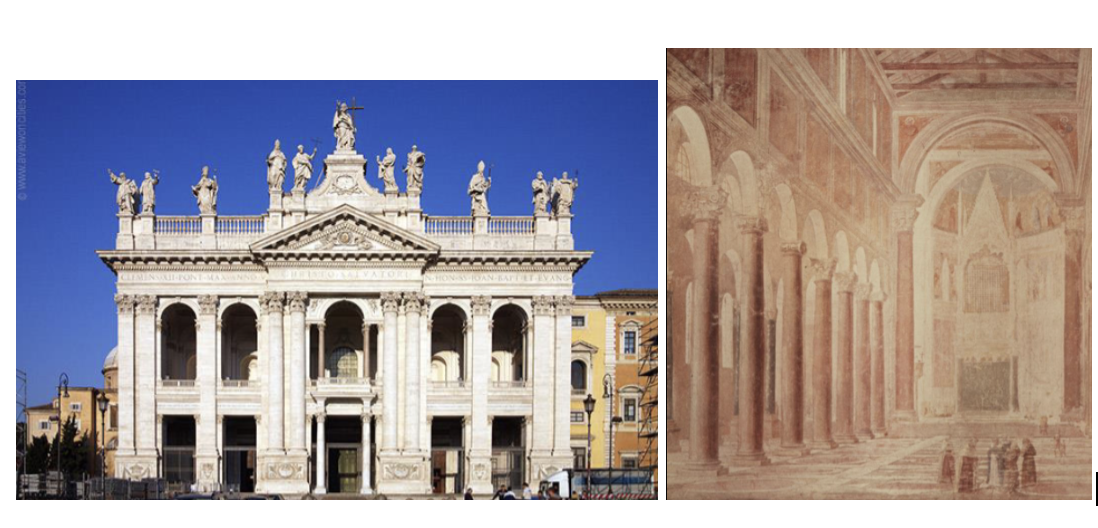
Basilica of St. John the Lateran, 7th century, was demolished and a new smaller palace was placed on it, but the Baptistry remains. It is the cathedral of the bishop of Rome (the Pope). Contained a large fastigium or screen between the nave and apse.
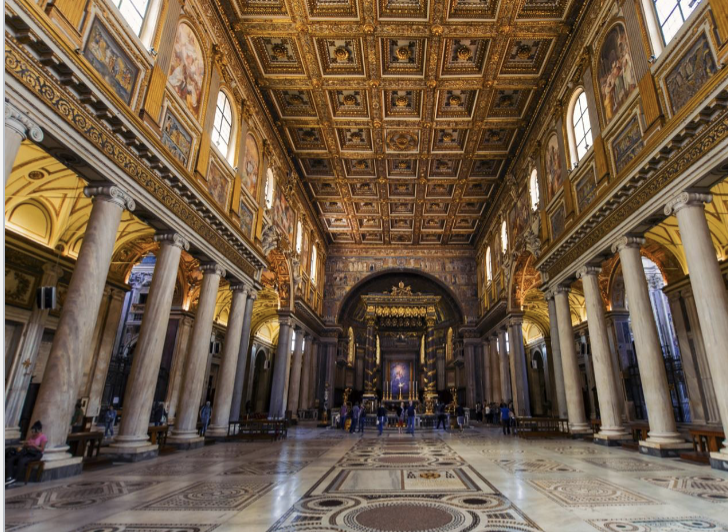
Santa Maria Maggiore, Rome, early 5th century, built immediately after the 431 Council of Ephesus, which affirmed Mary as the “Mother of God” —> Theotokos, contains many tombs of Popes.
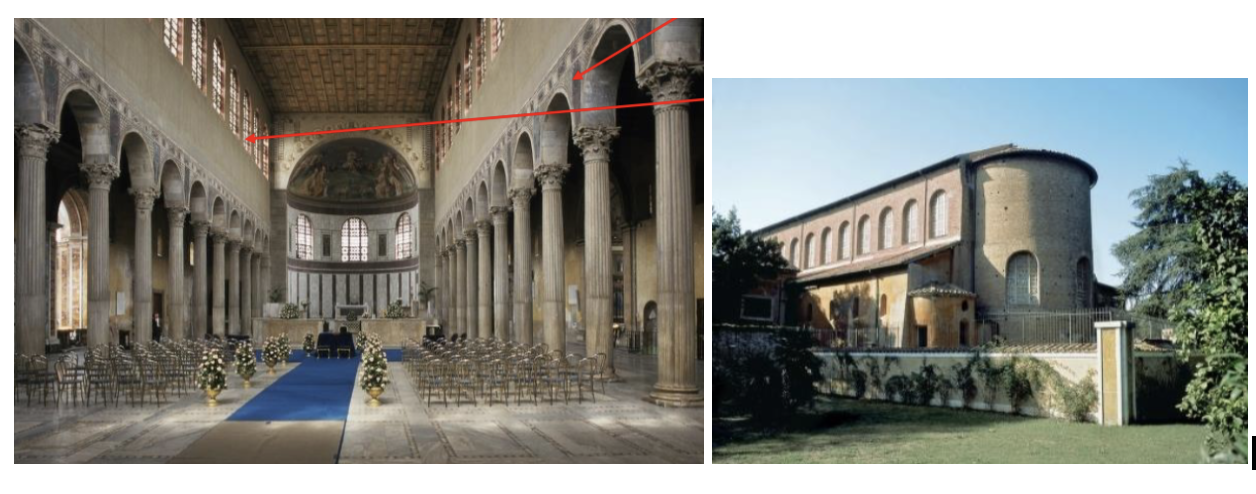
Santa Sabina, Rome, early 5th century, arches rather than architraves, filled with opus sextile. Windows covered in mica. Corinthian columns, spolia. Part of the popularization of using arches rather than architraves.

Old St. Peter’s, Rome, early 4th century, demolished and rebuilt in the 16th century. Choir with baldachin, tomb of St. Peter. Church as martyrium (a church or place where a Christian martyr is buried). Contains a transept and atrium.

San Juan de Baños, Spain, mid 7th century, looks like a mini-basilica, interior columns are spoil, the altar area has a barrel vault. Visigothic (germanic people living in what is now Spain).
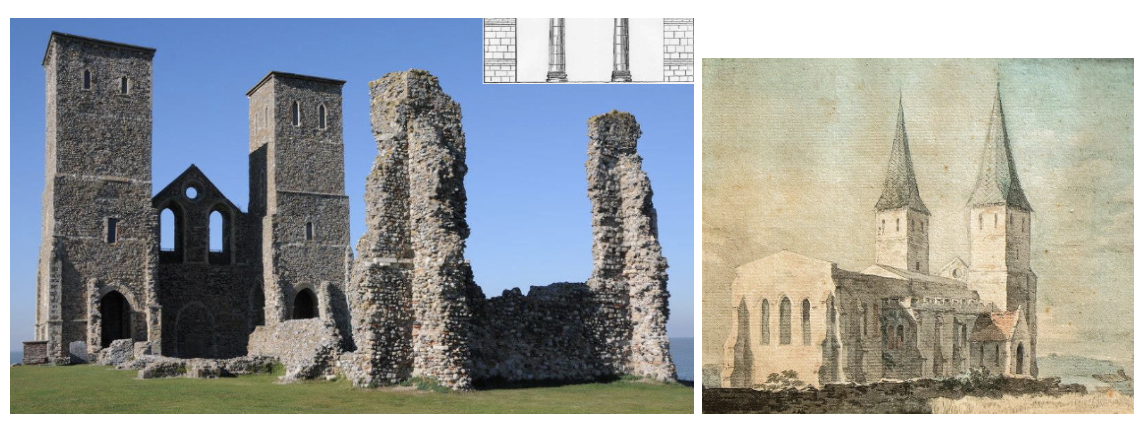
St. Mary’s Church, Reculver (Kent), England, late 7th century. First Christina missions to England from Rome were in the early 7th. Original church had an eastern apse, no side aisles, and two side chapels from each side of the apse. Had an arch or templon separating the nave from the apse. Demolished in the early 19th century.
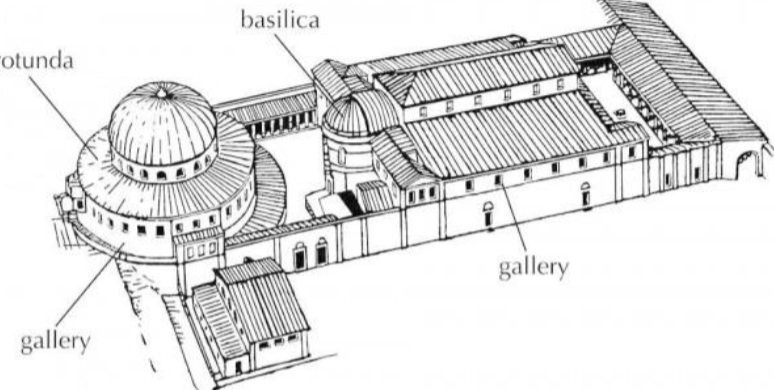
Holy Sepulchre, Jerusalem, Israel, mid 4th century. Combination of a basilica and a martyrium very much like St. Peters, although this one has a separate rotunda from the basilica.

Mausoleum of Santa Constanza, Rome, mid 4th century, centrally-planned. Funerary space planned for before the death of Santa Constanza but finished after her death. Her sarcophagus is made of porphyry.
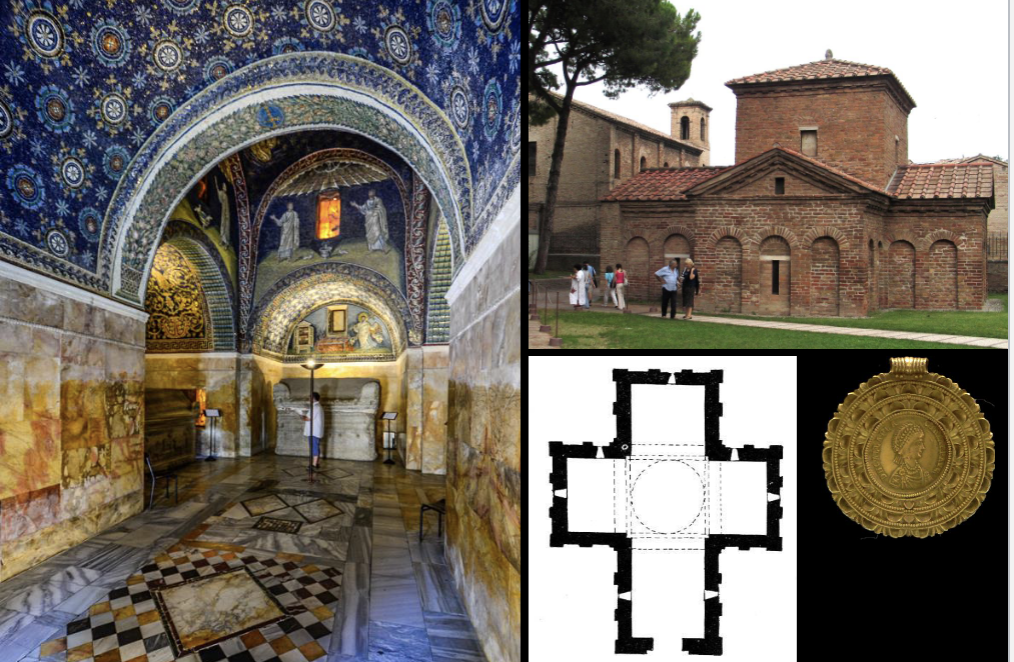
Mausoleum of Galla Placidia, Ravenna, Italy, early 5th century, cruciform shape with central barrel vaulted ceiling over main body. Many mosaics, pieces of decorative marble, opus sectile. Sarcophagi are in the arms of the cross, with a central larger empty sarcophagus.

Mausoleum of Theodoric, Ravenna, Italy, early 6th century. Centrally planned, built of masonry (stone) that was brought from very far. Ten sided structure on the lower portion, circular area above serving as clerestory to allow light in. Large dome roof with single block of limestone (insane task in antiquity). The tomb was probably sealed off from visitors.

Cathedral (or Orthodox) Baptistery, Ravenna, mid 5th century. Centrally-planned, eight-sided structure, domed. Marble, opus sextile, stucco, mosaics. Had a water font or piscine in the middle to hold sacred water for performing baptisms. Still survives today while the Lateran was demolished. Symbolic associations with death and resurrection (with baptism, those who are brought into the faith experience a metaphorical death and rebirth into Christ).
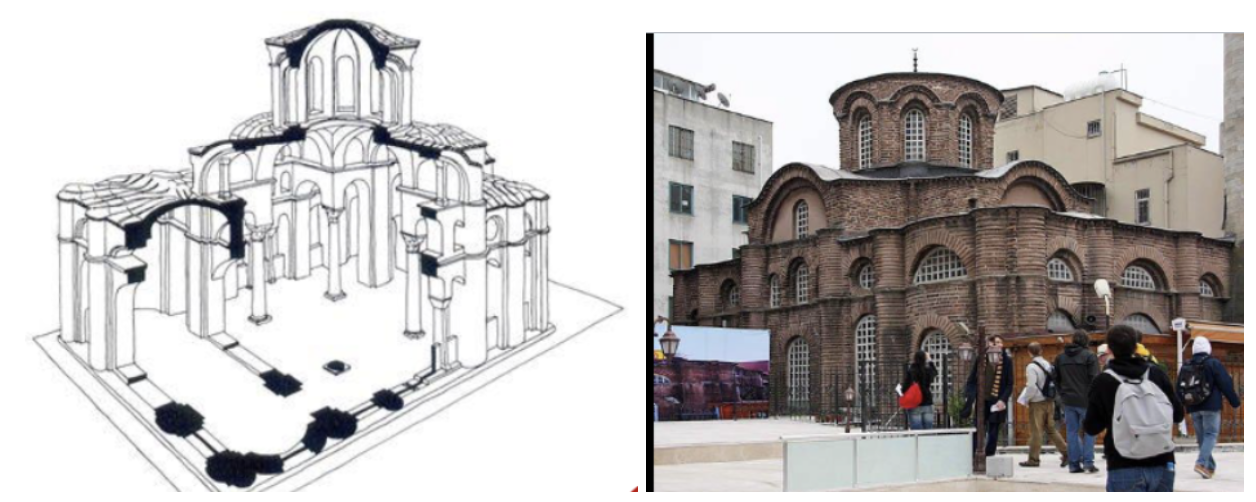
Myrelaion, Constantinople, early 10th century. Cross-in-square church, which is centrally-planned at first glance, but the dome is within four columns forming a square, kind of resembles a cruciform structure (this area is the naos). Has several areas in the apse, the prothesis — communion prepared, the bema — altar and bench, and the diakonikon — housed liturgical vestments and texts.
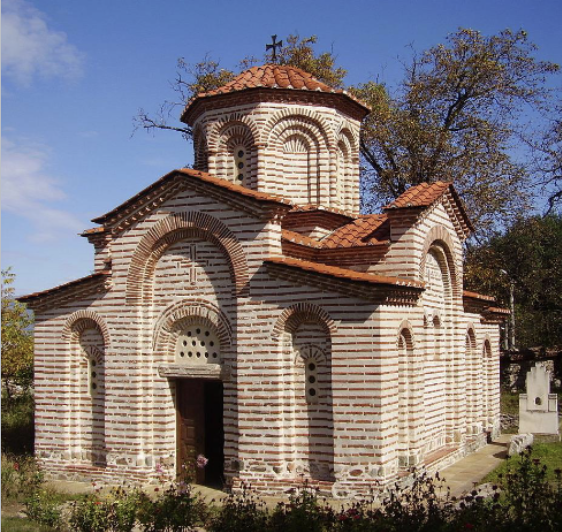
Church of St. George, Bulgaria, 10th to 11th century. Cross-in-square church, very decorative on the exterior compared to most other churches who reserve that for the interior. Smaller holes for windows, interesting archways with voussoir.
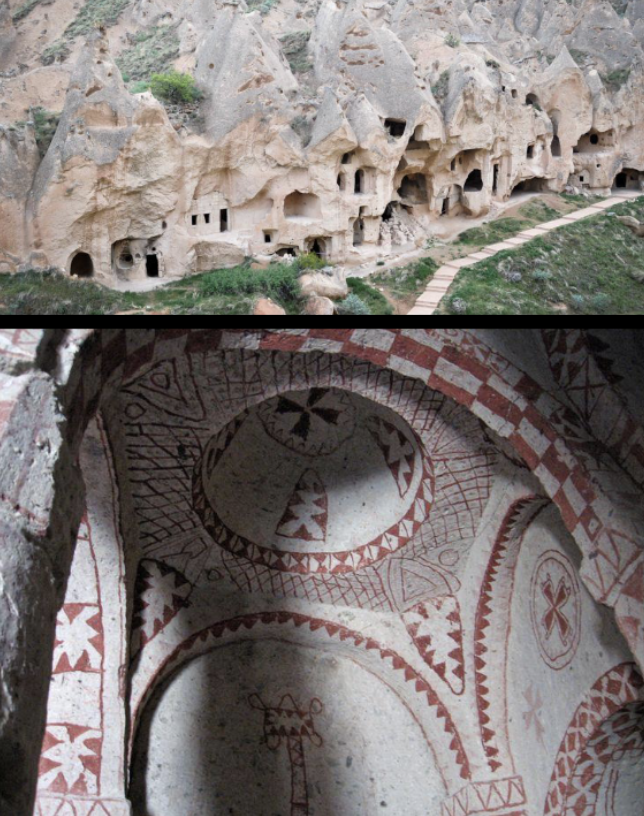
Church of St. Barbara, Cappadocia, 11th century. Cross-in-square church built into the rock, with paintings interior that mimic arches and domes, as there is a sacred meaning associated with those architectural elements and they will be replicated even in spaces where its impossible to seriously make them.
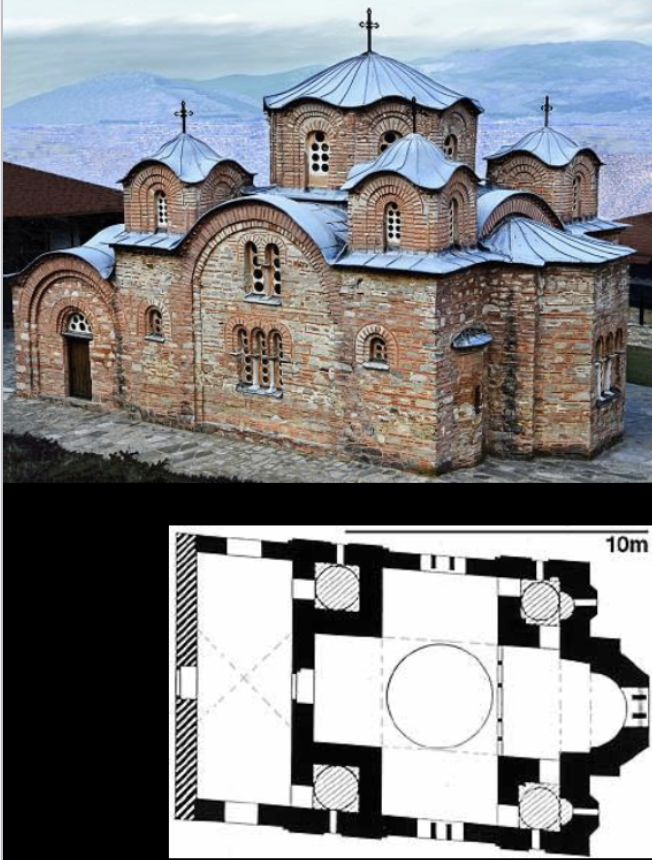
Church of St. Panteleimon, Nerezi, Macedonia, 12th century. Cross-in-square church with five domes (a central one with four corner domes around it. Seemed to have served funeral functions mainly although most cross-in-square served all purposes (both worship and funeral and baptism).
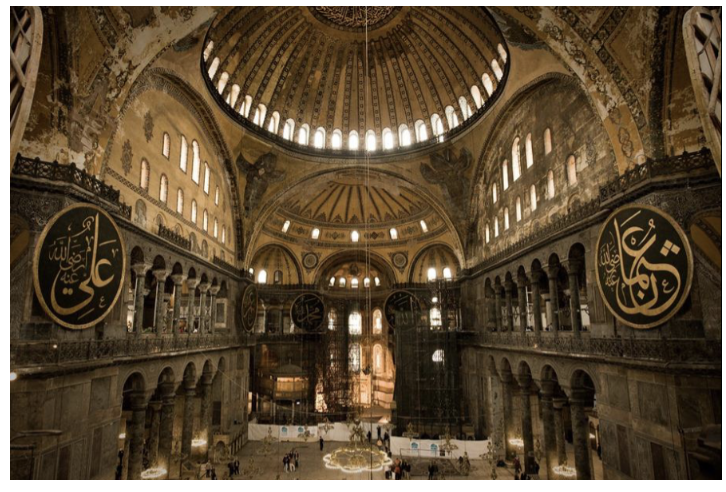
Hagia Sophia, Constantinople, early-6th century. Built by Emperor Justinian I following the Nika revolts against him which destroyed much of the city. The architects were Anthemius of Tralles and Isidorus of Miletus. Dedicated to Holy Wisdom, the concept of Christ as Holy Wisdom. Unique blend of basilica and centrally planned structures, with a large central dome held up by pendentives and supported on two sides by half-domes with exedrae recessed into the walls. A long nave with an eastern apse and altar, side aisles with a gallery and clerestory. Beautiful marble inlay (opus sextile) in the floor and walls, and very famous mosaics (tesserae) in the narthex and on the ceilings and walls. Incredible light comes from the windows in the dome and on the sides, illuminating the area and reflecting off the gold-foil and precious stone. Was initially a church built by Constantine II in the mid 3rd century and then rebuilt by Justinian. Served as a church, cathedral, mosque, museum, and then mosque again.
Mosaic of the Donors
10th century mosaic depicting Emperor Constantine and Justinian presenting the city of Constantinople and Hagia Sophia to mother Mary and Jesus. (in Hagia Sophia)
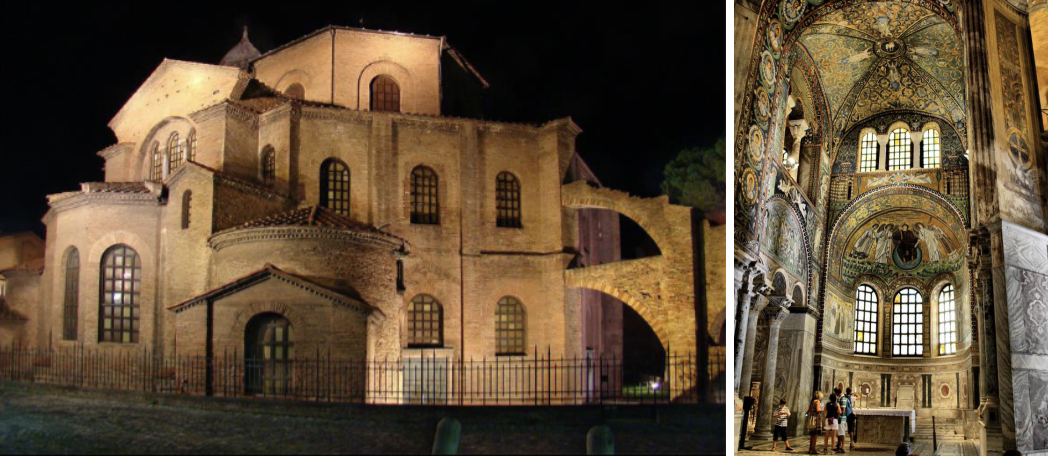
San Vitale, Ravenna, mid 6th century. Centrally planned with exedrae framing it (7 sides), small rectangular vaulted space and apse in the 8th side. Funded by a local banker and founded by Bishop Ecclesius and Emperor Justinian. Gallery space around the central dome, very vegetal ornamental motifs, with opus sectile around the seat of the bishop. Labyrinth designs in the floor. Mosaics of Justinian, the bishops, members of his court and military, also empress Theodora and her court. Preserves its original mosaics and color because it wasn’t a site of conflict like Hagia Sophia.

The Monastery of St. Catherine, Mount Sinai, 6th century. Funded by Justinian following the death of his wife Theodora. Built on the site where Moses received the Ten Commandments. Main church plan is basilica and cross-in-square, and not perfectly centered in the complex. Not only a place of worship but also a major collection of holy items over time.
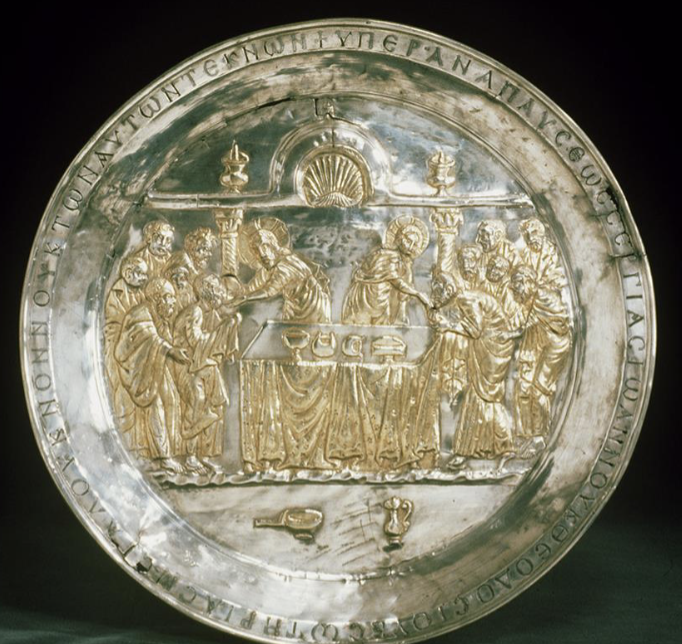
The Riha Paten, late 6th century, shows the Communion of the Apostles, created in repoussé technique.
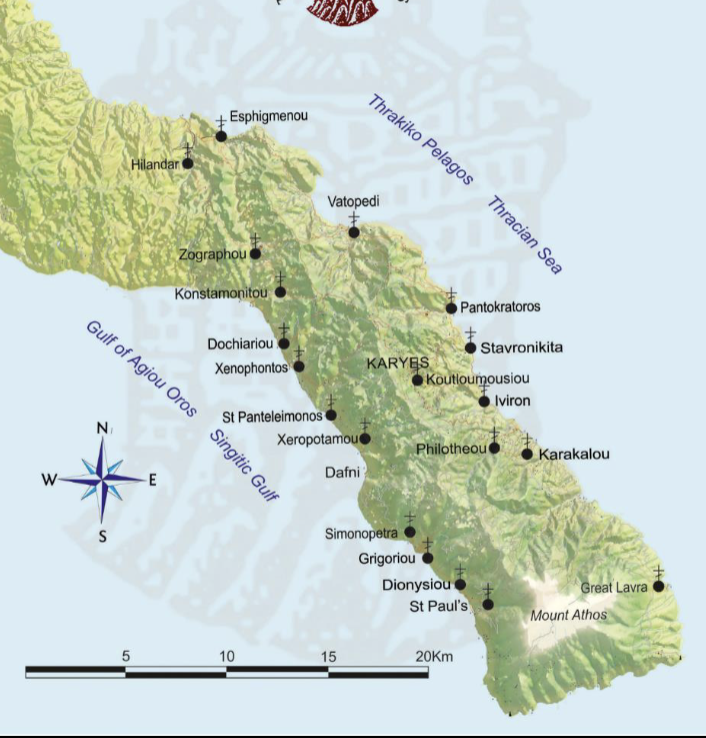
Mount Athos, northeastern Greek peninsula, monasteries built from the 10th to 14th century. Does not allow women on the premises even today. Twenty monasteries in total. Received many holy objects just like St. Catherines —> a tradition due to the chrysobull or decree of jurisdiction and support made by the Emperor over the monasteries.
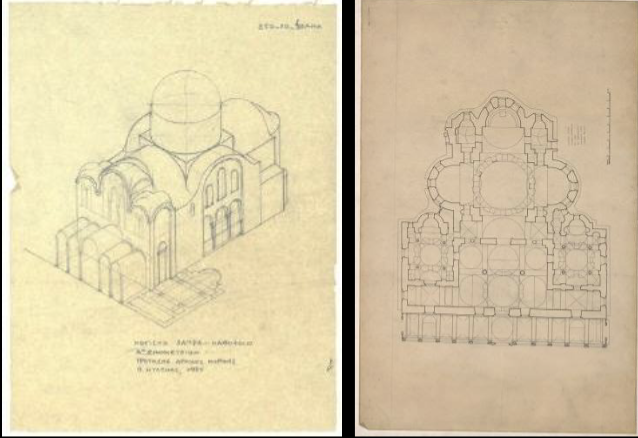
Great Lavra monastery, mouth Athos, rebuilt 10th century. Tri-conch cross-in-square floor plan, overall somewhat cruciform shape as well.
Chrysobull of Andronikos II Palaiologos
Emperor Andronikos II Palaiologos placed the monasteries of Mount Athos under the jurisdiction of the Patriarchate of Constantinople, issued in 1300.
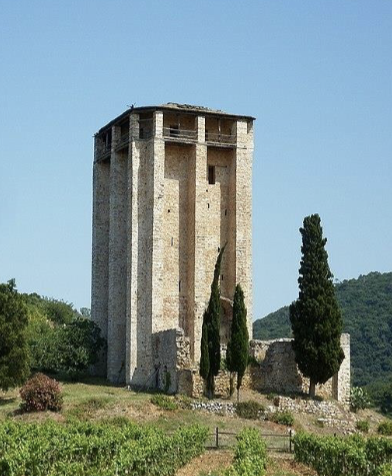
Tower of King Milutin, Hilander Monastery, early 14th century. Very unique design, military structure within a monastery.
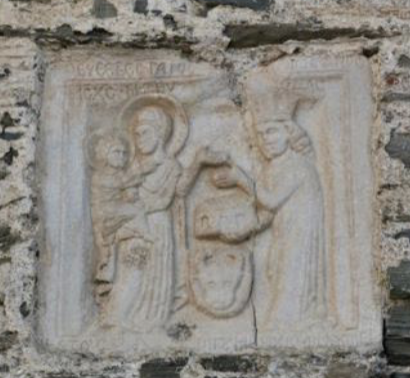
Votive relief of Stephen III, Vatopedi, late 15th century. Commemorates his patronage of the monastery. Similar in vibes to mosaic of the donors in Hagia Sophia and San Vitale.
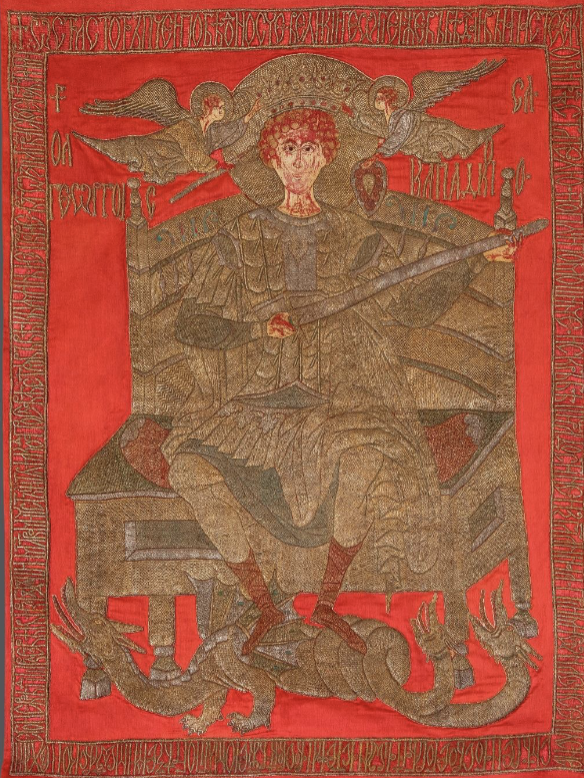
Liturgical Standard of St. George, 16th century. Processional banner used in religious ceremonies in the Byzantine tradition. Symbol of his victory and status as a great martyr.
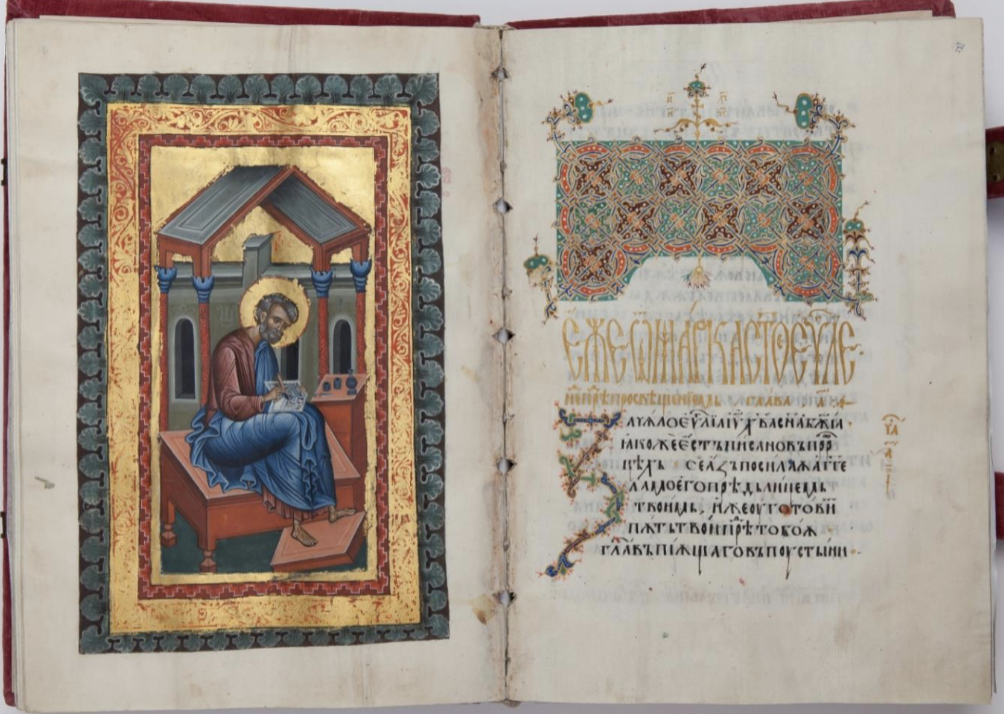
Tetraevangelion (Book of the four gospels), religious text. Religious practice of reading all four gospels in churches.
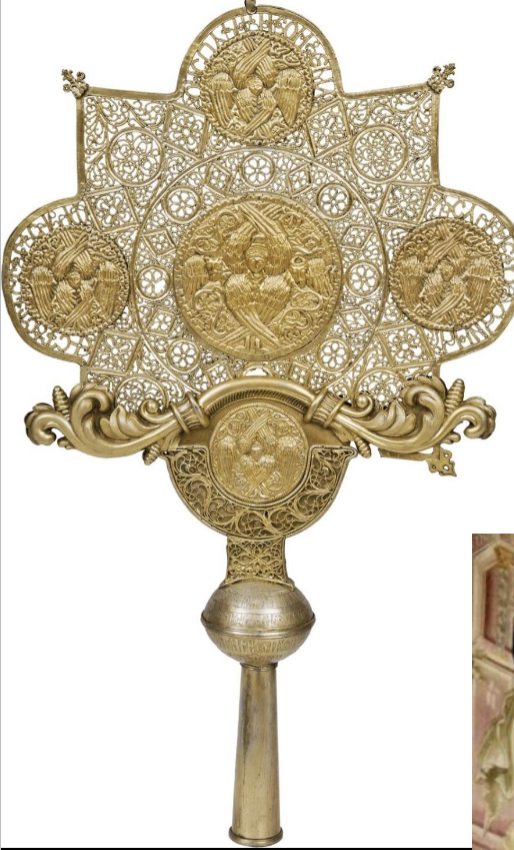
Rhipidia, 1497, liturgical fan, gilded in silver. Monastery in Romania. Supposed to represent angels and the protection of the Eucharist/communion (blood and body of Christ).
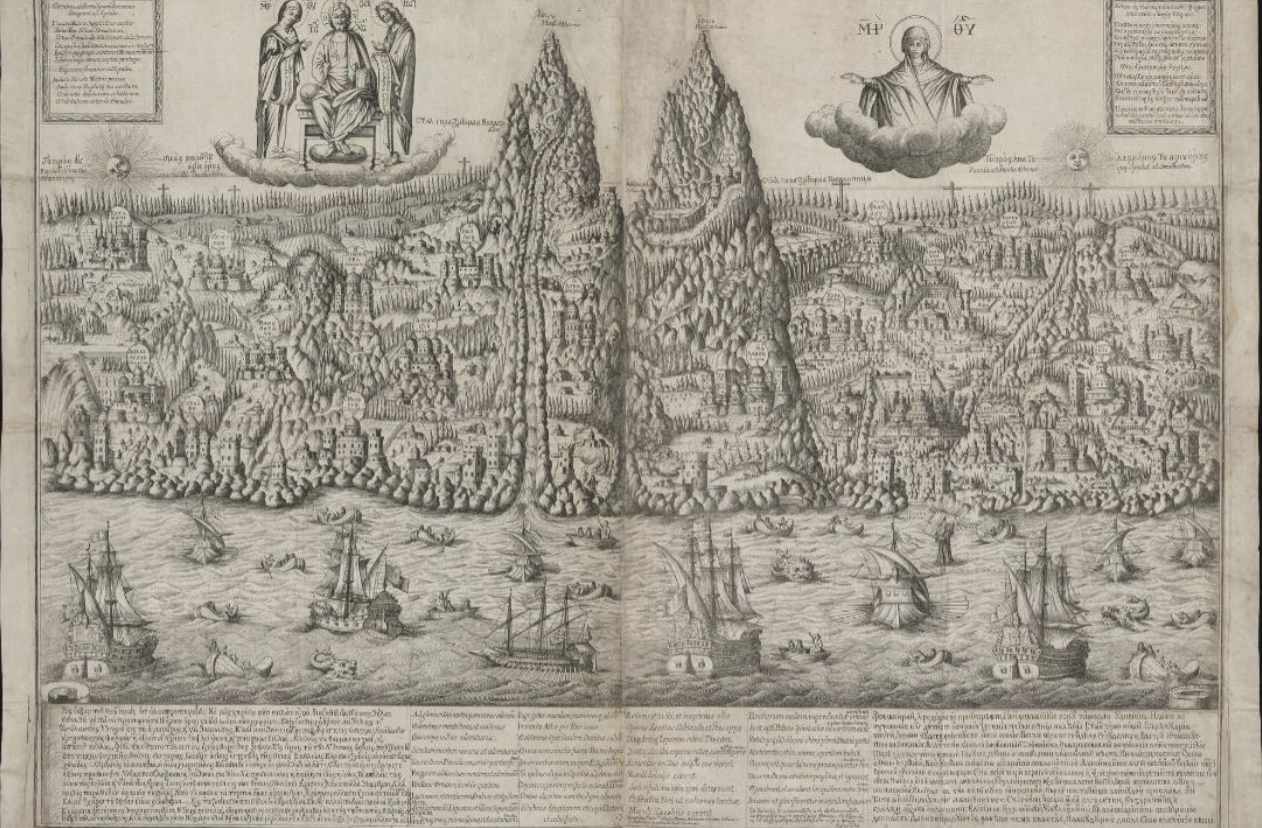
General View of Mount Athos by Alessandro dalla Via, late 18th century. Shows both western and eastern sides of peninsula. Very dramatic.
Emperor Leo IV kneeling before Christ
Imperial gate of Hagia Sophia mosaic, showing the supplication of even the Emperor to Christ/God. Nobody is above God and everyone is in his domain/worship.